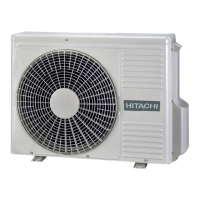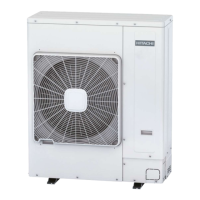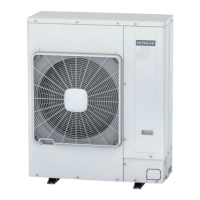1-17
TROUBLESHOOTING
1.2 Troubleshooting Procedure
Alarm Code Indication of Remote Control Switch
1.2.1 Alarm Code Table
COOL
Indoor Unit
Number
Alarm Code
Indicated
for a second
alternately
MED
A/C
ADDS. RN
ALARM
COOL
Connected No.
of Indoor Units
Alarm CodeModel Code
MED
A/C
ALARM
Code
No.
Category Content of Abnormality Leading Cause
01
Indoor Unit Tripping of Protection Device
High Water Level in Drain Pan,
Activated Float Switch.
02
Outdoor Unit
Tripping of Protection Device
(Except Alarm Code 41 and 42)
Activated High Pressure Switch.
Locked Motor in Cooling Operation.
03
Abnormality between Indoor and Outdoor
Incorrect Wiring. Loose Terminals,
Disconnected wire, Tripping of Fuse.
04
Abnormality between Inverter and Control PCB Failure in Transmission of PCB for Inverter.
06
Voltage Drop
Voltage Drop by Excessively Low or High
Voltage to Outdoor Unit
Voltage Drop of Power Supply
Insufficient Capacity of Power Supply Wiring.
07
Decrease of Discharge Gas Superheat
Discharge Gas SUPERHEAT less than
10 deg. is maintained for one hour.
08
Increase of Discharge Gas Temperature
Temperature of the top of Compressor: Td
Td 127
o
C(Cooling), Td 120
o
C(Heating)
over 10 minutes, or Td 140
o
C over 5 seconds.
11
Inlet Air Thermistor
12
Outlet Air Thermistor
13
Freeze Protection Thermistor
14
Gas Piping Thermistor
19
Tripping of Protection Device
Activated Internal Thermo of Fan Motor.
20
Compressor Thermistor
22
Outdoor Air Thermistor
24
Evaporating Thermistor
31
Incorrect Capacity of Outdoor and Indoor Unit
Incorrect Setting of Capacity Combination or
Incorrect O.U. Capacity Setting.
35
Incorrect Indoor Unit No. Setting Duplication of Indoor Unit No.
36
Incorrect Combination of Indoor Unit
FSG2E series connects to HVRG series outdoor unit
(European Area Only).
HRG series of the indoor unit is connected to FSG(1)
and FXG(1) series outdoor units (European Area Only).
38
Abnormality of Protective Circuit in outdoor Unit Failure of Protection detecting Circuit
41
Overload cooling
(Possibility of high pressure device activation.)
O.U. Pipe Thermistor Temp. is Higher than 55
o
C
and the Comp. Top Temp. is Higher than 95
o
C
when O.U. Protection Device is activated.
42
Overload heating
(Possibility of high pressure device activation.)
I.U. Freeze Protection Thermistor Temp. is Higher
than 55
o
C and the Comp. Top Temp. is Higher than
95
o
C when O.U. Protection Device is activated.
47
Activation of Low Pressure Decrease
Protection Device
Stoppage by Excessively Decrease of evaporating
Temperature ( Te -35
o
C) is activated 3 times in
one hour, Locked Motor in Heating Operation.
51
Abnormality of Current Sensor for Inverter
Failure of Control PCB, ISPM
52
Activating Overcurrent Protection Failure of ISPM, Clogging of Heat Exchanger.
53
Activating Protection of ISPM
ISPM Abnormality
Failure of Compressor, clogging of Heat Exchanger.
54
Inverter Fin Temperature Increase
Abnormal Inverter Fin Thermistor,
Clogging of Heat Exchanger
Abnormal Outdoor Fan
57
Outdoor Fan Fan Motor Abnormality
Disconnected wire or Incorrect wiring between
Control PCB and Inverter PCB.
Incorrect Wiring or Fan Motor Abnormality
EE
Compressor Compressor Protection Alarm Failure of Compressor.
Inverter
Transmission
Failure of Thermistor, Loose Terminal,
Disconnected Wire.
Locked Motor in Heating Operation.
Sensor on
Outdoor Unit
Pressure
Cycle
Sensor on
Indoor Unit
Failure of Thermistor, Loose Terminal,
Disconnected Wire.
System
> >
>
<

